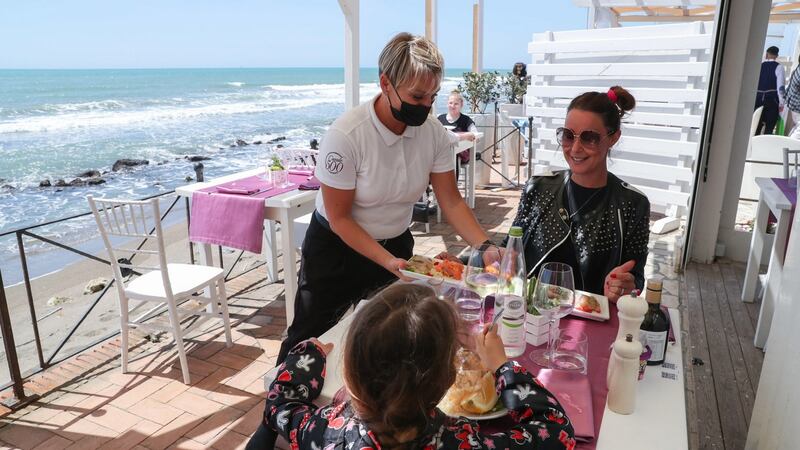The EU’s biggest countries are lifting coronavirus restrictions in the hope that accelerating vaccination programmes will allow a speedier return to normal life. But epidemiologists worry the shift is coming too soon and that progress could yet be reversed.
Over little more than a week, France lifted its travel ban, Spain allowed its six-month old "state of alert" to lapse and Germany eased lockdown. Italy has also steadily loosened restrictions over the past month, with people anticipating returning soon to gyms and indoor pools.
Although the EU’s infections have roughly halved from early April, they remain high in some places, with hospitals under pressure and deaths per week still numbering roughly 1,500 in France and Italy, 1,000 in Germany, and around 600 in Spain.

Antoine Flahault, director of the Institute of Global Health at the University of Geneva, warned the goal "should be to get the virus to a low ebb" across Europe before the summer travel season.
“We need to get to lower levels if we don’t want to restart the problems again too quickly,” he said. “If some places get stuck on a moderate to high plateau, the summer and autumn will be very complicated.”
Overall, the 14-day case notification rate stands at 277 per 100,000 people in the 30 countries tracked by the European Centre for Disease Prevention and Control, down from 489 on April 1st.
The fall has come as vaccines have arrived en masse, and as the EU’s rollout has largely focused first on the most vulnerable people in society rather than those at greatest risk of infection.
About 30 per cent of the EU population has received at least one dose, according to Our World in Data – twice the level of a month ago, although still well below rates in leading countries Israel, the UK and the US.
But many health professionals worry that the level of protection remains too low to guard against further increases in infections as curbs are relaxed.
‘Very worried’
It takes about two weeks for rule changes to show up in infection data and hospitalisations and deaths take longer still. So it is still too soon to tell which trend will win out: vaccinations pushing rates down or looser restrictions pushing them back up.
The one thing people can agree on is that the next month will be crucial.
In France, Lila Bouadma, who heads an intensive care unit at Bichat Hospital in Paris and advises the government, expressed concern about her country's plan to reopen by June 30th. "The fact that the plan has very specific dates without any health metrics or criteria attached to them makes us very worried," she told France Info radio.
France will reopen outdoor bars and restaurants and non-food retail outlets on Wednesday. It is still logging around 14,000 infections daily, but Flahaut’s model predicts that will fall to around 11,000 by reopening.
Prime minister Jean Castex defended France's scheme as gradual. "We are finally making our way out of this crisis once and for all," he told Le Parisien newspaper. "There will be measures taken if the situation gets out of control locally," he added, without giving specifics.
But the country’s scientific advisory panel has called – so far without success – for France to adopt a similar approach to Germany, which requires infections to fall to set levels before each phase of reopening.
‘Emergency brake’
This month, German authorities relaxed the country’s six-month lockdown after incidence dropped to 96.5 cases per 100,000 people over seven days, the first time it has dipped below 100 since March 20th. In Bavaria, for example, beer gardens, cinemas and theatres have been allowed to reopen since May 10th.
But if the metric rises above 100 cases again, an “emergency brake” will automatically come into force, with restrictions such as night-time curfews.
Even so, Lothar Wieler, head of the Robert Koch Institute, Germany's main public health authority, warned that incidence remained "still too high" with about 173 of Germany's 412 districts remaining above 100.
Health minister Jens Spahn added that while the latest numbers were "gratifying", Germans should "take great care not to let this confidence turn into recklessness".
Similar concerns have been voiced in Spain, where the legal order that underpinned national coronavirus restrictions ended on May 9th, sparking public jubilation and bitter political disputes. With its passing, some regions have scaled back restrictions while others face legal challenges over keeping curbs in place.
Many people’s initial response was to party: police broke up a mass gathering of young people in Madrid’s central Puerta del Sol the night before the change and there were similar scenes in Barcelona and elsewhere in the country.
Politicians have been less festive. The opposition People’s Party has fiercely criticised the leftwing government’s refusal to replace the state of alert with new legislation.
But prime minister Pedro Sánchez has justified the decision by saying the country is less than 100 days away from inoculating 70 per cent of the population. “The state of alert is the past,” the prime minister said. “The future is called vaccination, vaccination, vaccination.”
‘Critical juncture’
Indeed, while the state of alert was allowed to expire without clear metrics, infections in Spain have recently been running below other major EU economies.
But in Spain, as elsewhere, what really matters is the course of the disease over the next few weeks.
Bruno Lina, a virologist in Lyon who advises the French government, described what he called a "critical juncture".
“It could really get much better from here – that is a real possibility given the vaccination campaign and lower infections,” he said. “But we have to convince the public to continue being careful.” – Copyright The Financial Times Limited 2021









